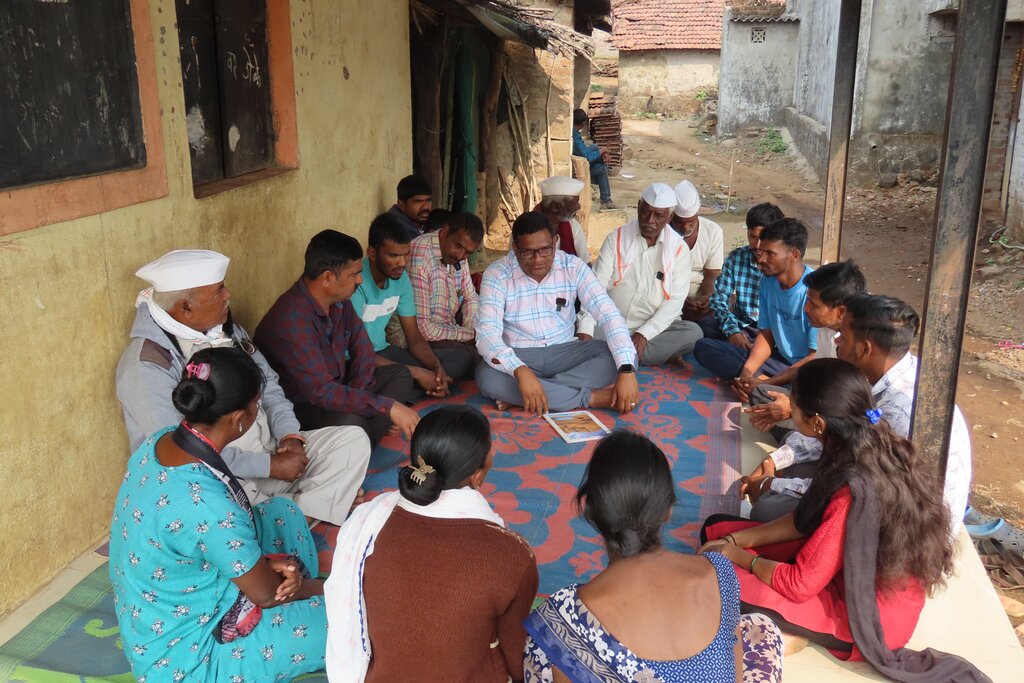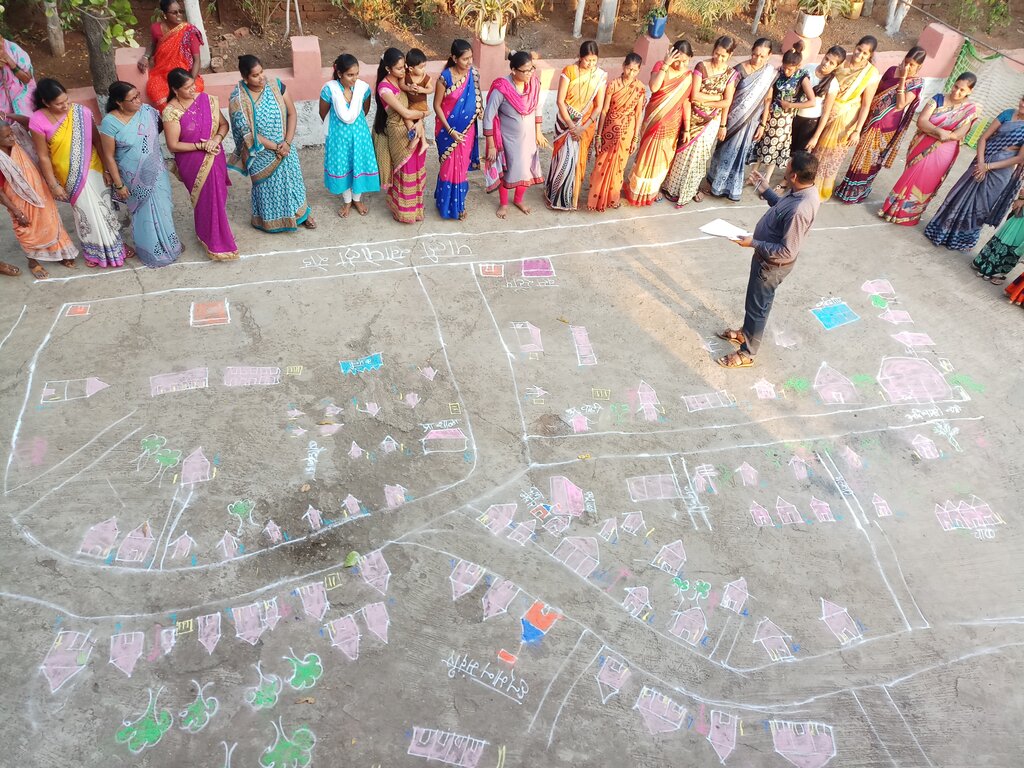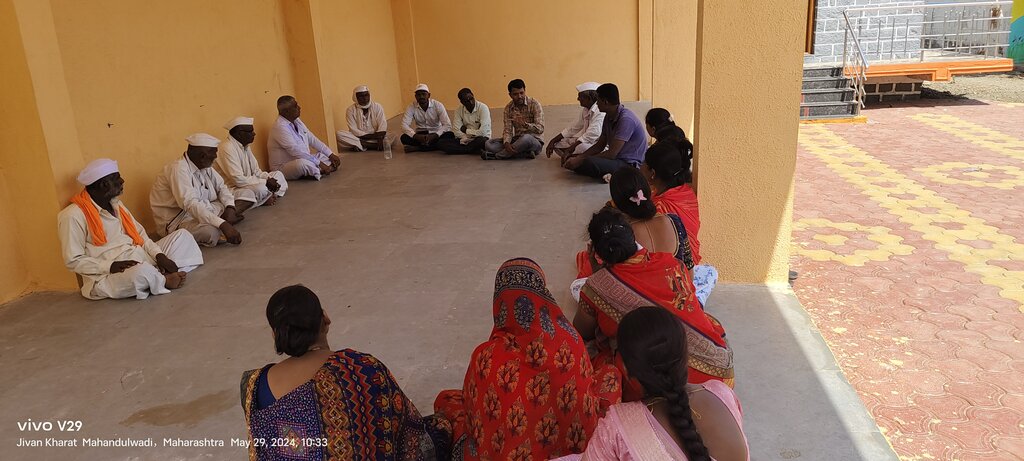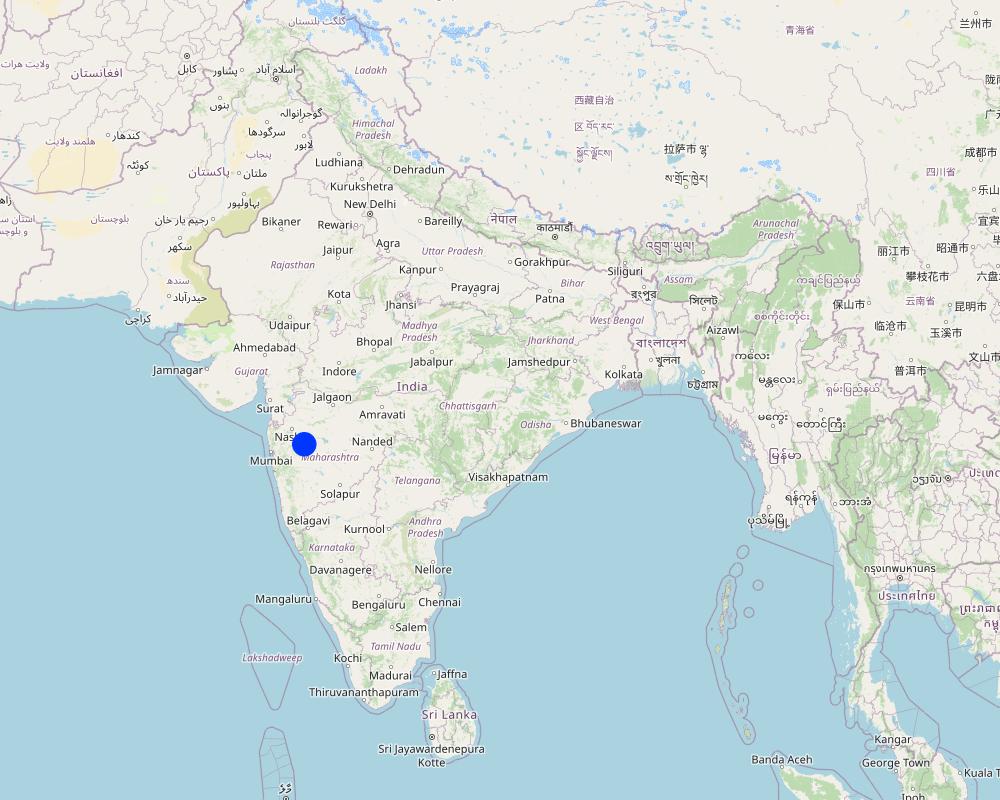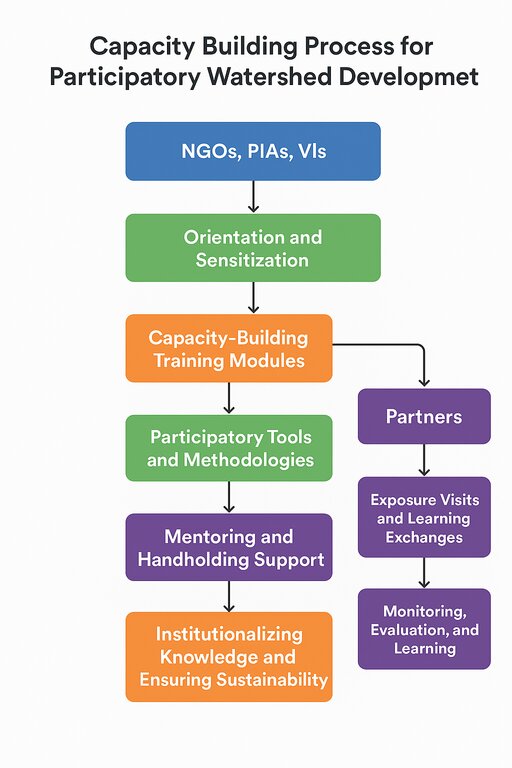Capacity Building Process for Participatory Watershed Development [Índia]
- Criação:
- Atualização:
- Compilador/a: Arun Bhagat
- Editor: –
- Revisor: Udo Höggel
Community Participation in Participatory Watershed Development
approaches_7656 - Índia
Veja as seções
Expandir tudo Recolher tudo1. Informação geral
1.2 Detalhes do contato das pessoas capacitadas e instituições envolvidas na avaliação e documentação da abordagem
Pessoa(s) capacitada(s)
Especialista em GST:
Rajapure Ganesh
+91 9422226412
ganesh.rajapure@wotr.org.in
Watershed Organisation Trust (WOTR)
Paryavaran Sarasnagar Road, Behind, Market Yard Road, Ahilyanagar, Maharashtra 414001
Índia
Especialista em GST:
D’Souza Marcella
+91 9422226415
marcella.dsouza@gmail.com
W-CReS (the WOTR Centre for Resilience Studies), Watershed Organisation Trust (WOTR), Pune
The Forum, 2nd Floor, Pune - Satara Rd, above Ranka Jewellers, Padmavati Nagar, Corner, Maharashtra 411009
Índia
Especialista em GST:
Especialista em GST:
Dadas Dada
+91 9892763960
dada.dadas@wotr.org.in
W-CReS (the WOTR Centre for Resilience Studies), Watershed Organisation Trust (WOTR), Pune
The Forum, 2nd Floor, Pune - Satara Rd, above Ranka Jewellers, Padmavati Nagar, Corner, Maharashtra 411009
Índia
Especialista em GST:
Khedkar Vishnu
+91 7798818283
vishnu.khedkar@wotr.org.in
W-CReS (the WOTR Centre for Resilience Studies), Watershed Organisation Trust (WOTR), Pune
The Forum, 2nd Floor, Pune - Satara Rd, above Ranka Jewellers, Padmavati Nagar, Corner, Maharashtra 411009
Índia
Nome da(s) instituição(ões) que facilitou(ram) a documentação/avaliação da Abordagem (se relevante)
Watershed Organisation Trust (WOTR) - Índia1.3 Condições em relação ao uso da informação documentada através de WOCAT
Quando os dados foram compilados (no campo)?
24/09/2025
O/a compilador/a e a(s) pessoa(s) capacitada(s) aceitam as condições relativas ao uso de dados documentados através da WOCAT:
Sim
2. Descrição da abordagem de GST
2.1 Descrição curta da abordagem
The Capacity Building Process for Participatory Watershed Development is a structured approach to strengthen the technical, managerial, and social skills of Non-Governmental Organizations (NGOs), Partner Implementation Agencies (PIAs), and Village-level Institutions (VIs). It includes orientation, training, participatory tools, mentoring, exposure visits, monitoring, and institutionalization. The process enhances competencies, fosters creativity and confidence, promotes community ownership, and ensures effective, sustainable planning, implementation, and management of watershed-based natural resource management and climate-resilient interventions.
2.2 Descrição detalhada da abordagem
Descrição detalhada da abordagem:
Capacity Building Process for Participatory Watershed Development:
Many Non-Governmental Organizations (NGOs), Partner Implementation Agencies (PIAs), and Village-level Institutions (VIs) aspire to implement participatory natural resource management (NRM) using a watershed approach. However, they often lack the technical expertise, practical skills, and experience needed for effective implementation. To address this gap, a structured capacity-building and induction strategy is essential. Such a strategy strengthen the technical and managerial competencies, nurtures creativity, and enhances their confidence to plan, implement, and sustain watershed interventions. In turn, it transforms their approach to resource mobilization, management, and sustainability. A common environmental challenge—such as water scarcity, land degradation, and climate change—creates opportunities to unite communities around shared needs. The Watershed Organisation Trust (WOTR) has effectively used watershed development as a unifying framework to bring people together, encouraging collective action for improving livelihoods and building resilience—especially among the poor and vulnerable.
Purpose of Capacity Building:
The overarching goal of the capacity-building process is to develop the knowledge, skills, attitudes, and confidence of NGOs, PIAs, and VIs in designing, implementing, and sustaining participatory, watershed-based NRM and climate-resilient development interventions.
Expected Outcomes:
•Improved competence in managing watershed-based NRM and climate change adaptation.
•Strengthened community ownership and participation.
•Effective and sustainable implementation of interventions.
•Positive transformation in approaches to resource mobilization and local governance.
Methodology and Key Steps:
The capacity-building approach comprises a series of interlinked steps, each reinforcing the others. Together, they form a comprehensive and adaptive learning process.
Step 1: Orientation and Sensitization
Objective: Build a common understanding and motivation among all project stakeholders.
Approach:
•Conduct orientation sessions explaining linkages between natural resources, livelihoods, and resilience.
•Share success stories and best practices to inspire commitment.
•Define roles and responsibilities of community-based organizations and NGOs.
Step 2: Capacity-Building Training Modules
Objective: Strengthen technical and managerial skills, especially among field-level stakeholders.
Core Modules:
•Technical Skills: Soil and water conservation, water budgeting, sustainable agriculture, climate resilience, and ecosystem-based adaptation.
•Social & Institutional Development: Social mobilization, gender inclusion, facilitation, group dynamics, and strengthening local institutions.
•Project Management: Planning, budgeting, reporting, and monitoring for effective implementation.
Step 3: Participatory Tools and Methodologies
Objective: Equip local groups with practical tools for participatory planning and action.
Tools and Methods:
•Participatory Rural Appraisal (PRA) tools such as resource mapping, seasonal calendars, and wealth ranking.
•Participatory Net Planning (PNP) for micro-level watershed planning.
•Use of digital tools and simple MIS platforms for data management and progress tracking.
Step 4: Mentoring and Handholding Support
Objective: Ensure continued learning, quality implementation, and motivation.
Approach:
•On-site technical and managerial guidance by experienced facilitators or resource NGOs.
•Regular review and feedback meetings to troubleshoot challenges.
•Peer learning and cross-visits among different project sites for shared learning.
Step 5: Exposure Visits and Learning Exchanges
Objective: Promote experiential and peer-to-peer learning.
Approach:
•Organize visits to successful watershed and NRM sites.
•Facilitate interactions with experienced community institutions and farmer groups.
•Encourage farmer-to-farmer extension to build local confidence and innovation.
Step 6: Monitoring, Evaluation, and Learning (MEL)
Objective: Foster accountability, reflection, and adaptive learning.
Approach:
•Train partners in participatory monitoring, data collection, documentation, and reporting.
•Develop and use simple, participatory monitoring tools to track outcomes and learning.
•WOTR’s existing participatory MEL tools are adapted for partners to ensure consistent data and insights.
Step 7: Institutionalizing Knowledge and Ensuring Sustainability
Objective: Build long-term local ownership and reduce dependence on external support.
Approach:
•Develop local resource persons, for example para-professionals.
•Establish local training and resource centers for continuous on-the-ground support.
•Document best practices, lessons learned, and local innovations for knowledge sharing.
•Gradually transfer leadership and responsibility to community institutions.
2.3 Fotos da abordagem
Observações gerais sobre as fotos:
Photos of activities like resource mapping are important as they visually document community participation, local knowledge, and the planning process. They help capture the involvement of villagers, the use of PRA tools, and the mapping outcomes. Such photos serve as powerful evidence of participatory planning, support monitoring and reporting, and effectively communicate project processes and impacts to stakeholders and partners.
2.5 País/região/locais onde a abordagem foi aplicada
País:
Índia
Região/Estado/Província:
Maharashtra, MadhyaPradesh, Telangana, Karnataka, Jharkhand, Odisha, Chhattisgarh states
Especificação adicional de localização:
Ahilyanagar, Jalna, Hyderabad, Sanga Reddy, Mandala, Gajapati, Rayagada, and more, etc.
Comentários:
Watershed Organisation Trust (WOTR), established in 1993, has been actively engaged in capacity building since its inception (Stared from this location). This participatory approach continues to be implemented in WOTR-supported villages across nine states in India.
Map
×2.6 Datas de início e término da abordagem
Caso o ano exato seja desconhecido, indique a data aproximada de início da abordagem:
10-50 anos atrás
Comentários:
Year of termination is not applicable because capacity building is essential in participatory watershed management.
2.7 Tipo de abordagem
- The capacity-building process (approach) combines traditional and indigenous knowledge, recent local innovations, and project or program-based approaches for effective and sustainable watershed management.
2.8 Principais metas/objetivos da abordagem
The main aims/objectives of the Capacity Building Process for Participatory Watershed Development are
• Strengthen technical, social, and managerial skills of NGOs, PIAs, and Village-level Institutions for effective watershed management.
• Promote participatory planning, community ownership, and active engagement in watershed interventions.
• Build project management capacity, including planning, budgeting, monitoring, and reporting.
• Support continuous learning through mentoring, exposure visits, and peer exchanges.
• Ensure sustainability by institutionalizing knowledge, developing local resource persons, and transferring leadership to communities.
2.9 Condição que propiciam ou inibem a implementação de tecnologia/tecnologias aplicada(s) segundo a abordagem
Normas e valores sociais/culturais/religiosos
- Propício
Living together for a common purpose forms the foundation of society. A strong sense of ownership and active participation is essential for achieving sustainable development.
Disponibilidade/acesso a recursos e serviços financeiros
- Propício
Transparency acts as a social audit, it serves as an effective tool for accountability and openness.
Quadro institucional
- Propício
It provides a platform for community members to develop and exercise leadership.
Colaboração/coordenção de atores
- Propício
It forms the foundation for building strong and sustainable institutions.
- Inibitivo
Conflicts may arise among community members due to differing opinions, taboos, or perceptions.
Quadro jurídico (posse de terra, direitos de uso da terra e da água)
- Propício
Village-level Institutions (VIs) are linked with the local governing body, i.e., the Village Panchayat.
Políticas
- Propício
It facilitates the process of social auditing.
Governança da terra (tomada de decisões, implementação e aplicação)
- Propício
It enhances community participation in planning and implementation.
Conhecimento sobre GST, acesso a suporte técnico
- Propício
Through training that provides technical knowledge on the project’s key components.
Mercados (para comprar entradas, vender produtos) e preços
- Propício
Training materials can be procured.
Carga de trabalho, disponibilidade de força de trabalho
- Propício
Provides local animators to assist in project implementation.
3. Participação e papel das partes interessadas envolvidas
3.1 Partes interessadas envolvidas na abordagem e seus papéis
- Usuários de terra/comunidades locais
Farmers, Women, and Youth
Consent to work, willingness to participate in mobilization activities, and attendance at capacity-building events.
- Organizações comunitárias
Men, Women, and Local Representatives
Making informed decisions and managing conflicts effectively. Encouraging active community participation, carefully selecting beneficiaries, and monitoring the impacts of interventions.
- Especialistas em GST/ consultor agrícola
NGO staff and team members
Planning, implementing, and monitoring activities
- Pesquisadores
Researchers and community members (men and women) involved in planning, implementation, and impact monitoring
Researchers design and guide training activities, facilitate knowledge sharing, provide technical expertise, monitor progress, and assess the impact of interventions to strengthen the skills and capacities of communities and stakeholders.
- Professores/alunos/estudantes
School and nursery teachers.
Facilitating learning, guiding children, and supporting community education initiatives
- Organização não governamental
Board members
Board resolution
- Setor privado
Technical Expert - Individual or Group
Support to the SLM specialist
- Governo local
Gram Panchayat (PRI)
Local governance body
Necessary resolutions
- Governo nacional (planejadores, responsáveis pelas decisões)
Concern Departments
Content and Guidelines for Capacity-Building Efforts
- Organização internacional
Donor Agencies
Content and Guidelines for Capacity-Building Efforts
Funding, technical support, and guidance for community development and capacity-building initiatives
Caso várias partes interessadas foram envolvidas, indique a agência líder:
The main implementing agency will take the lead role in planning, coordinating, and executing the activities (Capacity-building processes are closely linked to project implementation, so the project’s nodal agency takes the lead role).
3.2 Envolvimento do usuários de terra/comunidades locais nas diferentes fases da abordagem
| Envolvimento do usuários de terra/comunidades locais | Especifique quem estava envolvido e descreva as atividades | |
|---|---|---|
| Iniciação/motivação | Automobilização | Community members need to demonstrate their willingness to actively participate in project planning and implementation. |
| Planejamento | Participativo | Farmers, CBO (Community-Based Organisation) members, women, and village-level animators actively participate in planning and review meetings, and contribute by passing resolutions in CBO meetings. |
| Implementação | Participativo | Farmers, CBO members, women, and the project team actively participate in executing activities and in collecting relevant contributions. |
| Monitoramento/avaliação | Participativo | CBO members participate in joint monitoring visits and share information for impact documentation and research studies. |
| Participativo |
3.3 Fluxograma (se disponível)
Descrição:
This visual is illustrating a Capacity Building Process for Participatory Watershed Development using a step-by-step flowchart.
It starts with key implementing institutions such as NGOs, PIAs, and Village Institutions (VIs). The process begins with Orientation and Sensitization, followed by Capacity-Building Training Modules that strengthen skills and technical knowledge. From here, the approach branches into two parallel components:
1. Participatory Tools and Methodologies → enabling communities to actively take part in planning and decision-making.
2. Partners → supporting collaboration through exposure visits and knowledge sharing.
The next stage provides Mentoring and Handholding Support to guide field-level implementation.
Finally, the process moves to Institutionalizing Knowledge and Ensuring Sustainability, ensuring that skills, systems, and learnings remain within the community for long-term development impact. Overall, the diagram shows a structured learning pathway that builds capacity, supports practical application, and ensures sustainable watershed management.
Autor:
Dr. Arun Bhagat
3.4 Decisão sobre a seleção de tecnologia/tecnologias de GST
Especifique quem decidiu sobre a seleção de tecnologia/tecnologias a serem implementadas:
- todos os atores relevantes, como parte de uma abordagem participativa
Explique:
The NGO plays a leading role in initiating the process, while community members become actively involved as the process progresses.
Especifique em que base foram tomadas as decisões:
- Avaliação de conhecimento bem documentado de GST (tomada de decisão baseada em evidências)
4. Suporte técnico, reforço das capacidades e gestão do conhecimento
4.1 Reforço das capacidades/ formação
Foi oferecida formação aos usuários da terra/outras partes interessadas?
Sim
Especifique quem foi capacitado:
- Usuários de terra
- Equipe de campo/consultores
Caso seja relevante, especifique gênero, idade, status, etnia, etc.
Community members of all age groups.
Tipo de formação:
- Em exercício
- Agricultor para agricultor
- Áreas de demonstração
- Reuniões públicas
Assuntos abordados:
Key concepts and topics include: Environmental degradation, Natural Resource Management, Watershed Development, Participatory planning and monitoring tools, Community participation and contributions, Role of stakeholders, Portfolio management, Women empowerment, Gender inclusion, Sustainable agriculture, and Post-project management.
Comentários:
Training modules are designed to meet the specific needs of the project and location.
4.2 Serviço de consultoria
Os usuários de terra têm acesso a um serviço de consultoria?
Sim
Especifique se foi oferecido serviço de consultoria:
- nas áreas dos usuários da terra
Descreva/comentários:
In today’s era of climate change and volatile markets, Indian farmers face growing challenges that affect productivity and food security. Unlike urban areas that benefit from the digital revolution, rural farmers need timely, localized, and actionable information on sustainable farming practices. WOTR’s FarmPrecise app addresses this need, providing a comprehensive, data-driven tool to support informed agricultural decisions. Previously, WOTR developed an Agromet Advisory System delivering crop- and location-specific advisories via SMS using data from the India Meteorological Department (IMD). While valuable for weather forecasts, this system lacked personalization and direct farmer engagement.
WOTR launched the FarmPrecise app in 2019 to provide dynamic, farm-specific advisories. Since then, it has grown substantially, with over 1 lakh downloads, covering 30 crops across the Indian States of Maharashtra, Telangana, Odisha, and Madhya Pradesh, and is available in five languages: English, Hindi, Marathi, Telugu, and Odia.
4.3 Fortalecimento da instituição (desenvolvimento organizacional)
As instituições foram fortalecidas ou estabelecidas através da abordagem?
- Sim, significativamente
Especifique a que nível (níveis) as instituições foram fortalecidas ou estabelecidas:
- Local
Descreva instituição, papéis e responsabilidades, membros, etc.
Village Development Committee (VDC): Responsible for planning and executing project activities, selecting beneficiaries and work sites, managing conflicts, overseeing community contributions, ensuring quality supervision and monitoring, maintaining records, and conducting social audits.
Self-Help Groups (SHGs): Organize women into savings and credit groups and manage SHG operations.
Village Water Management Team: Promote water budgeting, coordinate water governance, and support sustainable water management practices.
Especifique o tipo de apoio:
- Reforço das capacidades/ formação
Dê mais detalhes:
Capacity-building inputs are delivered in a sequence of trainings aligned with the project cycle tenure.
4.4 Monitoramento e avaliação
Monitoramento e avaliação são partes da abordagem?
Sim
Comentários:
In regular Community-Based Organization (CBO) trainings, the monitoring component is a key focus area.
Caso afirmativo, esta documentação é destinada a ser utilizada para monitoramento e avaliação?
Sim
Comentários:
It is used for follow-up purposes as well as for knowledge dissemination.
4.5 Pesquisa
A pesquisa foi parte da abordagem?
Sim
Especifique os tópicos:
- Sociologia
- Economia/Marketing
- Ecologia
- Tecnologia
Dê mais detalhes e indique quem realizou a pesquisa:
The baseline survey tool is used for impact documentation. It helps reach beneficiaries to record their quality of life and assess the effects of project activities.
5. Financiamento e apoio material externo
5.1 Orçamento anual para o componente de GST da abordagem
Caso o orçamento exato seja desconhecido, indique a faixa:
- < 2.000
Comentários (p. ex. principais fontes de recursos/principais doadores):
Main sources of funding / major donors: National and international donors, and Corporate Social Responsibility (CSR) contributions.
5.2 Apoio financeiro/material concedido aos usuários da terra
Os usuários da terra receberam apoio financeiro/material para a implementação de tecnologia/tecnologias?
Sim
Caso afirmativo, especifique tipo(s) de apoio, condições e fornecedor(es):
Although not through direct financial or material support, land users (community) benefit from improved skills and knowledge, and gain advantages through active participation and involvement.
5.3 Subsídios para entradas específicas (incluindo mão-de-obra)
- Nenhum
Se a mão-de-obra pelos usuários da terra foi uma entrada substancial, isso foi:
- Voluntário
Comentários:
While labor is not required, participation of land users in the capacity-building process is essential. Landowners contribute their knowledge and time to share ideas and insights.
5.4 Crédito
Foi concedido crédito segundo a abordagem para atividades de GST?
Não
5.5 Outros incentivos ou instrumentos
Foram utilizados outros incentivos ou instrumentos para promover a implementação das tecnologias de GST?
Não
6. Análise de impactos e declarações finais
6.1 Impactos da abordagem
A abordagem concedeu autonomia aos usuários locais de terra, melhorou a participação das partes interessadas?
- Não
- Sim, pouco
- Sim, moderadamente
- Sim, significativamente
Greater awareness and better understanding of project management and its impact on project components led to higher participation
A abordagem propiciou a tomada de decisão baseada em evidências?
- Não
- Sim, pouco
- Sim, moderadamente
- Sim, significativamente
The progress of project components is presented in common meetings, such as Gram Sabhas, enabling CBO members to make informed decisions.
A abordagem auxiliou os usuários da terra a implementar e manter as tecnologias de GST?
- Não
- Sim, pouco
- Sim, moderadamente
- Sim, significativamente
Active and well-informed participation in planning, execution, and ensuring quality work.
A abordagem melhorou a coordenação e a implementação economicamente eficiente da GST?
- Não
- Sim, pouco
- Sim, moderadamente
- Sim, significativamente
Capacity building produces synergistic outcomes.
A abordagem mobilizou/melhorou o acesso aos recursos financeiros para implementação da GST?
- Não
- Sim, pouco
- Sim, moderadamente
- Sim, significativamente
The participatory Net Planning (PNP) tool in support of capacity building approach facilitates proper land-use planning with budget allocation for specific plots.
A abordagem aprimorou o conhecimento e as capacidades dos usuários da terra para implementar a GST?
- Não
- Sim, pouco
- Sim, moderadamente
- Sim, significativamente
Capacity building activities and net planning exercises provide inputs on the technical know-how of watershed structures.
A abordagem aprimorou o conhecimento e as capacidades de outras partes interessadas?
- Não
- Sim, pouco
- Sim, moderadamente
- Sim, significativamente
The capacity-building approach improved stakeholders’ knowledge and skills through training, hands-on exercises, participatory planning, and active involvement in decision-making.
A abordagem construiu/fortaleceu instituições, colaboração entre partes interessadas?
- Não
- Sim, pouco
- Sim, moderadamente
- Sim, significativamente
The capacity-building process brings all stakeholders onto a common platform, fostering a shared vision, sustainable impact, and resilience.
A abordagem atenuou conflitos?
- Não
- Sim, pouco
- Sim, moderadamente
- Sim, significativamente
It helps unite the community and reduces conflicts related to resource management.
A abordagem concedeu autonomia aos grupos social e economicamente desfavorecidos?
- Não
- Sim, pouco
- Sim, moderadamente
- Sim, significativamente
The principle of equity was upheld during the capacity-building process, with community members from all sectors actively involved and given equal representation in CBO and VI structures.
A abordagem melhorou a igualdade de gêneros e concedeu autonomia a mulheres e meninas?
- Não
- Sim, pouco
- Sim, moderadamente
- Sim, significativamente
Special emphasis was placed on women, with a separate Plan of Participation (POP) developed to ensure their inclusion and promote gender equity.
A abordagem encorajou os jovens/as próximas gerações de usuários de terra a se envolverem na GST?
- Não
- Sim, pouco
- Sim, moderadamente
- Sim, significativamente
Special focus was placed on engaging youth in the net planning process to ensure their active participation in local support and supervision.
A abordagem melhorou as questões de posse de terra/diretos do usuário que inibiam a implementação das tecnologias de GST?
- Não
- Sim, pouco
- Sim, moderadamente
- Sim, significativamente
Informal land user issues are resolved during the implementation process.
A abordagem resultou em segurança alimentar aprimorada/nutrição melhorada?
- Não
- Sim, pouco
- Sim, moderadamente
- Sim, significativamente
A well-designed capacity-building process ensures quality implementation, leading to better outcomes.
A abordagem melhorou o acesso aos mercados?
- Não
- Sim, pouco
- Sim, moderadamente
- Sim, significativamente
Market-related inputs are included in the training modules.
A abordagem resultou em acesso melhorado à água e ao saneamento?
- Não
- Sim, pouco
- Sim, moderadamente
- Sim, significativamente
A well-designed capacity-building process leads to quality implementation, resulting in positive outcomes.
A abordagem resultou em uso/fontes de energia mais sustentável?
- Não
- Sim, pouco
- Sim, moderadamente
- Sim, significativamente
The capacity-building approach promoted sustainable energy use by training stakeholders on efficient practices, demonstrating renewable technologies, and encouraging participatory planning for optimal resource use.
A abordagem aprimorou a capacidade dos usuários da terra de adaptar-se a mudanças climáticas/extremos e atenuar os desastres relacionados com o clima?
- Não
- Sim, pouco
- Sim, moderadamente
- Sim, significativamente
A well-designed capacity-building process, combined with effective training, ensures quality implementation, leading to positive outcomes and impacts, while enhancing individuals’ resilience through adaptation.
A abordagem resultou em emprego, oportunidades de renda?
- Não
- Sim, pouco
- Sim, moderadamente
- Sim, significativamente
Improved agriculture creates both on-farm and off-farm livelihood opportunities.
6.2 Principal motivação dos usuários da terra para implementar a GST
- Produção aumentada
Enhanced soil moisture and soil quality, along with increased awareness and adoption of improved agricultural practices.
- Degradação do solo reduzida
Reduced soil erosion and land degradation, along with improved knowledge of water and land management practices.
- normas e regulamentos (multas)/aplicação
Land users practice and uphold equality at all levels.
- Consciência ambiental
Integration of climate change–related topics into capacity-building strategies.
- melhoria dos conhecimentos e aptidões de GST
A structured and systematic process for implementing Sustainable Land Management (SLM) practices.
6.3 Atividades de sustentabilidade de abordagem
Os usuários da terra podem manter o que foi implementado através da abordagem (sem apoio externo)?
- Sim
Caso afirmativo, descreva como:
The principle of ‘learning by doing’ is central to the capacity-building process. Communities gain hands-on experience in various project components, developing strong technical and managerial skills at the local level. This enhances sustainability, as trained village institutions such as VDC members and community workers possess the necessary knowledge and skills for continued implementation and impact documentation.
6.4 Pontos fortes/vantagens da abordagem
| Pontos fortes/vantagens/oportunidades na visão do usuário da terra |
|---|
| Inclusion of Indigenous Knowledge: The approach allows local and traditional knowledge to be integrated into planning and implementation, making interventions more relevant and practical to the local context. |
| Enhanced Knowledge on NRM: Land users gain valuable knowledge and information about Natural Resource Management (NRM), helping them make informed decisions on soil, water, and land use practices. |
| Leadership Development: Community members get opportunities to take leadership roles in planning and decision-making processes, strengthening local governance and ownership. |
| Social Inclusion: The process ensures participation from all sections of society, including marginalized groups, women, and youth, promoting equity and collective action. |
| Pontos fortes/vantagens/oportunidades na visão do/a compilador/a ou de outra pessoa capacitada |
|---|
| Systematic Approach: The capacity-building process follows a structured and step-by-step framework, ensuring consistency, clarity, and efficiency in planning, implementation, and monitoring. |
| Tested and Proven Strategy: The approach is based on field-tested methodologies and past experiences, which have demonstrated successful outcomes in participatory watershed and NRM projects. |
| Operational Guidelines: Well-defined operational guidelines provide a clear roadmap for facilitators and implementing agencies, helping to standardize procedures and maintain quality across different project sites. |
| Set of Tools: The process includes a comprehensive toolkit—such as participatory planning tools, training modules, and monitoring formats—which helps streamline learning, participation, and evaluation. |
6.5 Pontos fracos, desvantagens da tecnologia e formas de superá-los
| Pontos fracos/desvantagens/riscos na visão do usuário da terra | Como eles podem ser superados? |
|---|---|
| Time Constraints: The capacity-building process requires continuous engagement, which can be time-consuming and may interfere with regular livelihood activities of land users. |
Flexible Organization of Capacity-Building (CB) Events: Conduct training and awareness sessions at times and locations convenient for community members to ensure higher participation, especially for women and farmers with field responsibilities. Use of Social Media and Digital Platforms: Share project updates, training materials, and success stories through WhatsApp groups, community radio, and other social media tools to reach a wider audience effectively. |
| Lack of Confidence to Participate: Some community members, especially those with limited education or exposure, may initially hesitate to engage actively in discussions or decision-making. |
Rapport Building: Establishing trust and positive relationships with community members helps facilitators engage participants more effectively and encourages open communication. Interactive Methods – Games, Exercises, Personal Talks, and Corner Meetings: Use participatory and informal methods to make learning enjoyable, build confidence, and promote active involvement among community members. Use of Participatory Rural Appraisal (PRA) Tools: PRA methods like mapping, ranking, and seasonal calendars help participants express local knowledge and experiences, increasing confidence and ownership in the planning process. |
| Social Constraints and Gender Barriers: Cultural taboos and social norms may restrict women’s participation in meetings or leadership roles, limiting their ability to contribute fully to capacity-building and project implementation. |
Encouraging attendance and use of Information: Motivate community members to regularly attend meetings, apply shared knowledge in their practices, and contribute ideas for better project outcomes. Confidence Building Among Men and Women: Conduct targeted sessions to enhance the confidence of both men and women, ensuring balanced participation and reducing gender-based hesitation in community discussions. |
| Pontos fracos/vantagens/riscos na visão do/a compilador/a ou de outra pessoa capacitada | Como eles podem ser superados? |
|---|---|
| Language and Cultural Barriers: Differences in language and cultural practices can make it difficult to communicate technical concepts effectively, especially in diverse and multi-lingual communities. | Rapport Building and Understanding of the Community: Spend adequate time in the field to understand local culture, traditions, and social dynamics. Building mutual trust enhances participation and improves the quality of capacity-building interventions. |
| Limited Literature in Local Language: The scarcity of training materials and technical documents in local languages restricts understanding and limits wider participation at the grassroots level. | Translation of Reading and Training Materials: Translate manuals, handouts, and key reference materials into local languages to make technical content accessible to all community members and ensure uniform understanding. |
| Communication and Facilitation Skills: Successful capacity building depends on skilled facilitators. In some cases, inadequate communication or facilitation skills among trainers can reduce the effectiveness of training sessions and field interactions. | Upgrading Skills of Trainers and Facilitators: Provide regular refresher training and exposure opportunities for facilitators to enhance their communication, facilitation, and technical skills—ensuring more effective delivery of capacity-building programs. |
7. Referências e links
7.1 Métodos/fontes de informação
- visitas de campo, pesquisas de campo
Two field visits are conducted to engage the village community in discussions on the capacity-building process, its impact, importance, and role in fostering ownership.
- entrevistas com usuários de terras
Interviews were conducted with six land users.
- entrevistas com especialistas em GST
Interviews were conducted with five land users.
- compilação de relatórios e outra documentação existente
The information is sourced from a capacity-building methodology that has been developed and is currently under publication.
7.2 Referências às publicações disponíveis
Título, autor, ano, ISBN:
WATERSHED DEVELOPMENT GUIDELINES (Revised 2001), Community and Rural Development Department,
Disponível de onde? Custos?
https://megcnrd.gov.in/forms/WSD.pdf
Título, autor, ano, ISBN:
The Wasundhara Approach. 2013. Watershed Organisation Trust (WOTR).
Disponível de onde? Custos?
https://www.yumpu.com/en/document/read/19427351/the-wasundhara-approach-wotr
7.3 Links para informação relevante que está disponível online
Título/ descrição:
Wasundhara Approach, Watershed Organisation Trust (WOTR)
URL:
https://www.youtube.com/watch?v=r3YHpkm9qFY&t=364s
Título/ descrição:
Water Gives Life, Watershed Organisation Trust (WOTR)
URL:
https://www.youtube.com/watch?v=thdevpZ-vio&t=149s
Título/ descrição:
How to do Wealth Ranking in Watershed
URL:
https://www.youtube.com/watch?v=ygiAy7f7Gpc
Título/ descrição:
Wasundhara
URL:
https://www.youtube.com/watch?v=r3YHpkm9qFY&t=364s
Título/ descrição:
A New Beginning
URL:
https://www.youtube.com/watch?v=LBzF7DXbedM&t=2s
Título/ descrição:
Rising Together: Building Resilient Communities for a Sustainable Tomorrow
URL:
https://www.youtube.com/watch?v=0gCFkwkfwdg&t=2s
Links e módulos
Expandir tudo Recolher tudoLinks
Não há links
Módulos
Não há módulos



